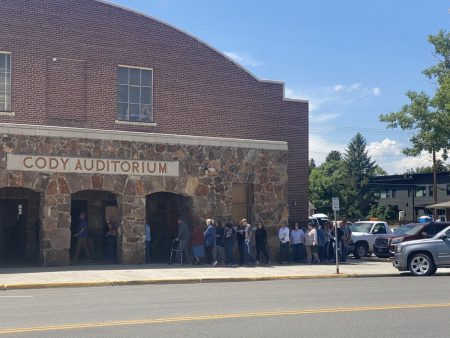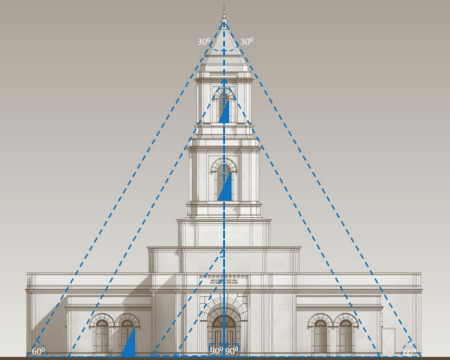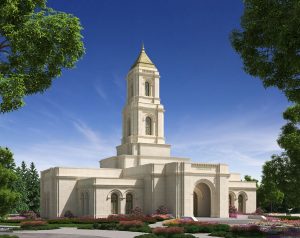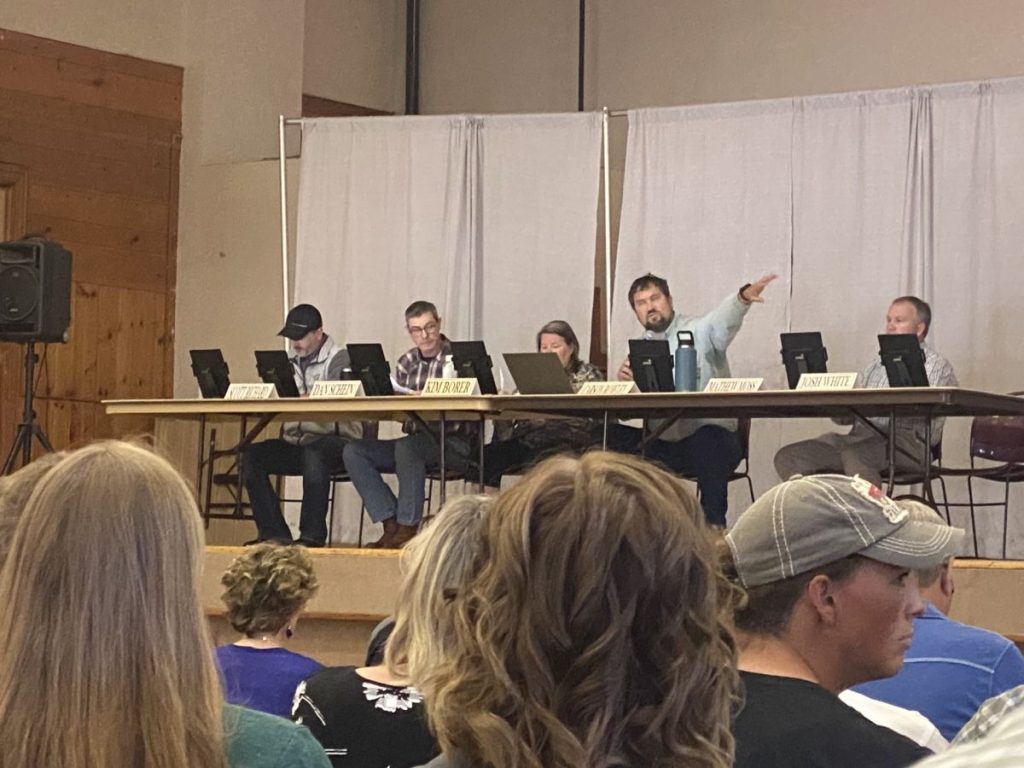There’s probably never been a time in the City of Cody’s history that there was a line of people waiting to attend a meeting of the Cody Planning, Zoning, and Adjustment Board. Yet, that was the scene outside the Cody Auditorium on Tuesday, June 27 – over a hundred Cody residents eager to hear the latest on the Church of Jesus Christ of Latter-Day Saints’ application for the Cody Wyoming Temple.
The first public meeting on the temple – to discuss a Special Use Permit and height exemption for the structure – was held at the Cody Auditorium on June 15. That meeting allowed public comment and lasted for several hours with three recesses.
The June 27 meeting was more subdued – the only people speaking were the six attending board members (Andy Quick has recused himself), City of Cody employees, and representatives of the L.D.S. Church.

Attendees may have been annoyed when Board Chairman Carson Rowley announced the first point on the agenda was a twenty-minute executive session to discuss matters that were “confidential by law.” The session ended within the twenty-minute period Rowley announced at the start.
Once the public portion of the meeting began, it quickly became apparent that there would be no decisive action that day. Too many questions remained for the board to approve the permit or the exemption, and much of the meeting was spent on “clarification” of the permit, the exemption, and the plans for the Cody Wyoming Temple.
The first speaker at the meeting was Sean Collier, the City of Cody’s Building Official (and not a member of the L.D.S. faith, something board member Matt Moss felt was important to have on the record.) Collier was presented as the most qualified person to discuss the current Building Code of the City of Cody.
Moss proceeded to ask Collier a series of questions, “building” to one conclusion: the Cody Wyoming Temple is entirely in compliance with the code and law of Cody – with or without a height exemption.
Collier explained that the temple is classified as “an A3 assembly/occupancy building” and is held to the same standard as other buildings within that classification. Based on this and Chapter 2 of the International Building Code, the temple’s 101-foot steeple/tower/spire (the exact term was a point of contention throughout the meeting) is not defined as a story or part of the roof. Instead, it is a rooftop structure and would not need a special exemption to be constructed.
Based on Cody’s building code, building a tall rooftop structure does not need a height exemption. In fact, Collier said any building in Cody could (in theory) have a similar structure of “unlimited height” if it is built with non-combustible material and is not used for storage or occupancy.
Board members Dan Schein and Kim Borer believe the public’s interpretation of building height is an important aspect to consider. Borer, in particular, said she had “no problem” with Collier’s analysis and the one submitted previously by City Planner Todd Stowell.
When Stowell first spoke, he expressed frustration with the board’s inclination to reject his interpretation of building height via the Cody Building Code “with no alternate explanation” for why such an exemption should be denied. Borer countered by defining, in her opinion, the public’s actual concern with the issue.
“It’s not heights, but building elevation,” Borer said, a comment that earned a small – and quickly stifled – round of applause.
Moss later said it was “tough” to ignore the analysis of city officials like City Planner Stowell, Building Official Collier, and Fire Marshal Sam Wilde. All three agree that the temple is in full compliance with city ordinances.

One factor raised throughout the meeting was the City of Cody’s Master Plan, adopted in March 2017. According to Borer, while the plan was “obviously” intended to be “a living, breathing document” to guide Cody’s future, it has been “left dusty on a shelf.” She cited moments like this as a sign the master plan needs to be cleaned off and utilized.
Later in the meeting, when confronted by the master plan and how it includes language on “preserving the character of existing neighborhoods,” Stowell reminded board members that the plan is “not adopted by ordinance.” The plan is intended to guide future growth but has no legal bearing.
At the conclusion of the meeting, Borer apologized to the audience for allowing the master plan to “get dusty” and implored city officials to revisit and abide by the master plan, now and in the future.
Moss made a motion to say the Cody Wyoming Temple complies with the building code and that a special exemption for the “tower” is unnecessary. The motion failed.
Schein made a motion that any approval of a Conditional Use Permit would be conditional on accepting the special exemption for the “tower.” That motion passed.
When discussing whether or not to discuss the Commercial Site Plan, board members spoke more candidly about their views. Moss called the temple’s plans “beautiful,” “considerate,” and “well thought out.” Borer said any vote on the current plan would be “a definite no” for her, as she believes the L.D.S. Church is showing “a lack of consideration” by not presenting a design more harmonious with the City of Cody’s character and desires.
Chairman Rowley said he agreed with Moss “to an extent” before raising his primary concern with the Cody Wyoming Temple: lighting. Many L.D.S. temples in other cities are brightly lit at night “to draw the whole earth unto them as a reminder of God and His ever-available light and love,” according to a memo submitted to the City of Cody by the temple’s architect, The Haskell Company.
Rowley said he had driven through Cody after 10 p.m. to see how other local churches light up their property. He observed that many churches have “rooftop structures,” but none are lit at night. He raised the concern over commercial vs. residential lighting and how the intensity and placement of exterior lights have been important factors for other recent projects to comply with, such as the Hampton Inn along Sourthfork Road.
Rowley spent considerable time discussing the Kelvin temperature of “warm” and “cold” light, which controls brightness and color. In the case of the Hampton Inn, it was agreed that the intended cold light of 4,000 Kelvin would be replaced with warmer 3,000 lights.
City Planner Stowell said the current lighting plan for the Cody Wyoming Temple (included in the application) complies with the standards of a city with a dark sky ordinance (something the City Cody does not have.) He reiterated that the exterior lights would gradually dim and turn off by 10 p.m.
Stowell also recalled a related incident he “questioned bringing up” at the meeting after talking to the City Attorney. Two local businesses wanted to add permanent holiday lighting to their buildings. At the time, it was determined that architectural lights were “off limits” – the City of Cody has no control over architectural lighting (except for parking lights.)
If the board rejected the temple proposal because of its lighting, Stowell said they were controlling “when people can turn on and off Christmas lights” in a residential area. He spoke of a “misunderstanding” that the Planning, Zoning, and Adjustment Board can “require more.”
“If it’s allowed for permitted use, it’s allowed for conditional use,” he said.
Schein “took exception” with Stowell’s holiday lighting analysis.
“The temple can’t be built (in a residential area) without a permit,” he said.
Greg Rasmussen, the Special Projects Manager for the Church of Jesus Christ of Latter-Day Saints, was on hand to answer questions. He acknowledged these were “difficult discussions.” He suggested that the best course of action might be for the Church to enter a development agreement with the City of Cody – something it has done in other municipalities. Board members seemed open to the possibility but tabled the issue for now.
Overall, the June 27 City of Cody Planning, Zoning, and Adjustment Board meeting proved essential and informative if unexciting. There were no opportunities for public comments and questions.
A monumental decision lies in the hands of the board. It will take more meetings in the future before anything about the Cody Wyoming Temple is accepted – or denied.
A date for the next public meeting of the Cody Planning, Zoning, and Adjustment Board that will consider the Cody Wyoming Temple has yet to be determined. The board regularly meets on the second and fourth Tuesday each month at Cody City Hall.

Courtesy Church of Jesus Christ of Latter-Day Saints










